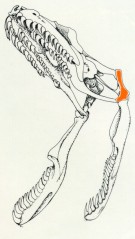Snakes have no teeth for chewing they only have biting and gripping teeth, the consequence of this is that they must swallow their prey hole. This is achieved by dislocation of their jaw as illustrated in the diagram. As snakes swallow their prey whole they require some very powerful digestive enzymes in fact their enzymes are so strong they even break down bones, it is only keratin (hair and claws) and chitin (insect shells) that snakes can't digest which they excrete. The digestive enzymes used by snakes are often found in the venom, when the snake bites its prey this speeds up the digestion process immensely as the digestion starts within their prey whilst they are swallowing it. Without the digestive enzymes in the venom digestion would be much slower as it is difficult to penetrate the tough animal hide with just external digestive enzymes.

 Images taken from
http://www.szgdocent.org/cc/c-eat2.htm
Images taken from
http://www.szgdocent.org/cc/c-eat2.htm